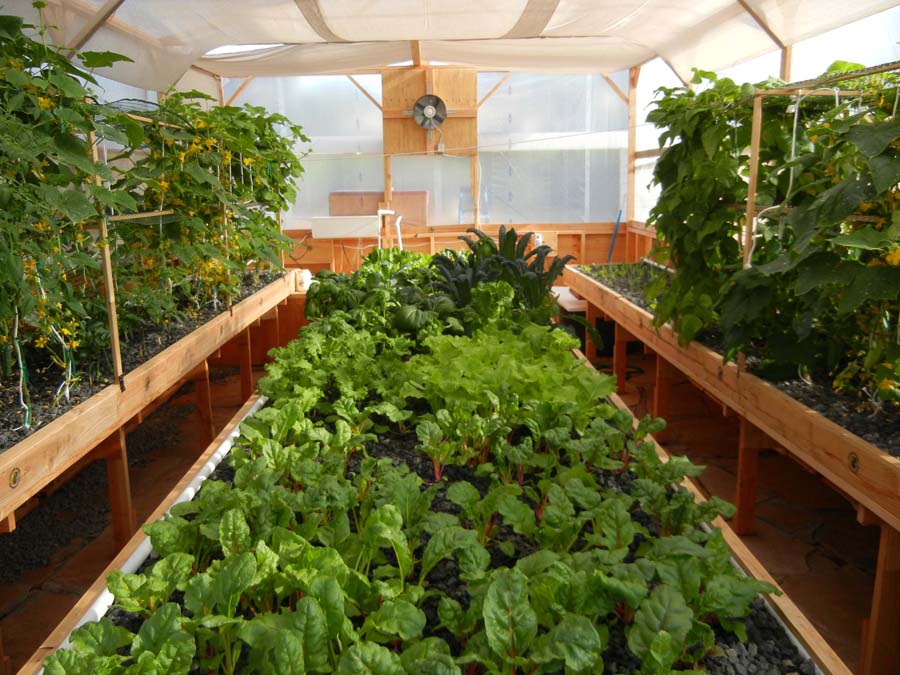If video is not visible, please UNBLOCK your browser to allow YouTube to play.
View a 2-minute video clip of the interior of 16 x 33′ Portable Farms® Aquaponics Systems – This small 16 x 33′ Portable Farms® Aquaponics Systems (in above video) feeds ten people the table vegetables and protein (tilapia) the food they need for optimal health – forever in 528 sq ft total space and 264 square ft grow space. This YouTube video has been viewed more than 70,000 times.
What is a Portable Farm?
 PFAS LLC offers a solution for year-round local growing of table vegetables and tank-raised fish as a protein source. Portable Farms® Aquaponics Systems grows food and fish in any climate and uses 95% less water than traditional agriculture.
PFAS LLC offers a solution for year-round local growing of table vegetables and tank-raised fish as a protein source. Portable Farms® Aquaponics Systems grows food and fish in any climate and uses 95% less water than traditional agriculture.
Portable Farms® Aquaponics Systems are related to agriculture and, more particularly, to the farming of aquatic animals and the use of their waste as fertilizing nutrients to grow vegetables in an automated closed loop drip-irrigation re-circulating system.
- Portable Farms® integrates aquaculture and hydroponics without the use of chemicals or pesticides.
- It can be operated by semi-skilled labor to plant seedlings, harvest produce and feed the fish.
- Portable Farms® are installed in climatically-adapted structures allowing for year-round growing in any climate.
- The produce can be grown between 28 days and 45 days. The fish can be harvested between seven and nine months at 1.2 pounds for two four-ounce fillets.
- The systems are designed with redundancies to eliminate catastrophic failure.
- Portable Farms® are designed to grow fresh-water, warm water fish such as tilapia, catfish, perch, and crawfish. Cold-water fish (such as trout) cannot be used in Portable Farms® because we use heaters in the tanks to keep the water temperature in the fish tanks to 75 to 80 degrees °F (23.8 to 26.6 °C).
- Portable Farms® do not grow grains, corn, squash or melons, root vegetables or perennials (berries, fruits, or asparagus, etc.) which are typically grow in soil. For example, aquaponics does not grow ‘root vegetables’ in the gravel that is used as the growing medium in Grow Tables. Examples of root vegetables are potatoes, beets, carrots, radishes, celery, etc. These root vegetables cannot move the gravel to thrive and mature.
- Electrical consumptions are minimal.
- Make-up water is 5 to 15 gallons maximum per grow table, per day.
If video is not visible, please UNBLOCK your browser to allow YouTube to play.
Phyllis Davis was awarded Second Prize after presenting Portable Farms® Aquaponics Systems to the San Diego Inventors Forum’s Annual Inventors Contest. View 8-minute presentation on YouTube video above (viewed more than 71,000 times).
Portable Farms® Aquaponics Systems Place in the Future
Since 2007, the PFAS LLC mission statement has always been to stop the cycle of poverty and end world hunger.
Agricultural practices are one of the major issues related to global-climate change. The twenty-first century is facing serious issues of drought, flooding, record- setting heat waves, soil and nutrient depletion, cost and maintenance of farm equipment, and an energy crisis that makes growing both expensive and difficult for farmers who face harsh challenges for raising and harvesting crops. Aquaponics is poised to be part of the solution to feed 9.3 billion people around the world:- In less than thirty years, 2050, the world will need to feed another two billion people on top of our current population of 7.9 billon.
- Feeding more than 9.3 billion people by 2050 will require a 60 percent increase in agricultural production and a 15 percent increase in water withdrawals.
- It takes 2.2 pounds of water (1 liter) to produce 1 pound of cereal (.45 kilograms).
- It takes 33,009 pounds of water (15,000 kilograms) to produce one pound (.45 kilograms) of meat.
